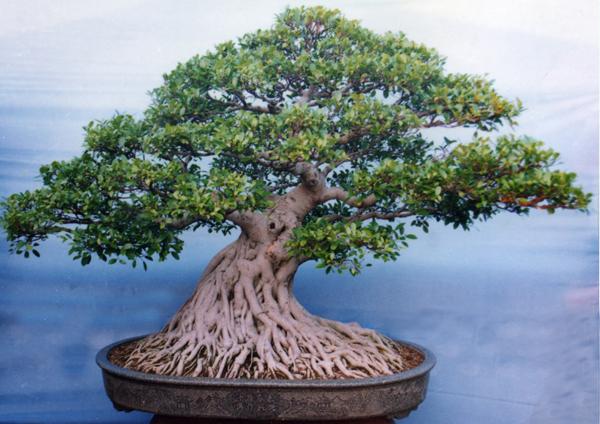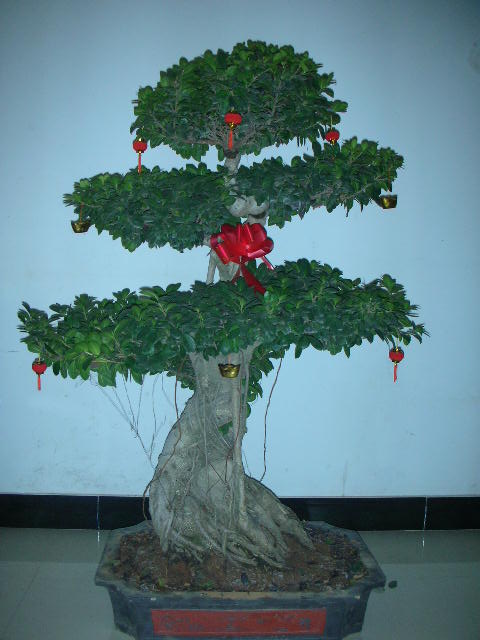[what if the little banyan tree loses its leaves] how to raise the small banyan tree
The banyan tree has green leaves, evergreen seasons, intertwined roots and ancient state, so it is an excellent indoor bonsai material. Small banyan bonsai can control its growth and development and cultivate it into a unique shape of banyan bonsai through pruning, pruning, hanging, grafting and other techniques. Next, the editor will introduce the indoor bonsai breeding method and how to raise the small banyan bonsai. What if the leaves of the small banyan bonsai fall off?

Summary of the reasons for the loss of leaves in bonsai of small banyan tree
1. It's not watered properly. Banyan watering must adhere to the principle of not drying, watering thoroughly. Drying here means that the surface of the basin soil is dry, not thoroughly, of course, even if it is dry, it will not cause great damage to the banyan tree in a short time, because the leaves of the banyan tree are thick and small, and have a certain degree of drought tolerance.
two。 Improper fertilization. The fertilization of banyan tree needs to be carried out by applying thin fertilizer frequently to avoid the application of high concentration chemical fertilizer or unfermented mature organic fertilizer, otherwise it will cause fertilizer damage, the light ones will lose their leaves and the heavy ones will die.
3. There is not enough light. The banyan tree grows well in the environment with sufficient light, and the leaf color is greener if it can shade 30-50% of the sun in summer, but it is best not to shade when the temperature is below 32 ℃ to prevent the leaves from falling off.

4. Caused by pests. The main pests that lead to defoliation of banyan trees are red spiders and shell insects, although there are also "thrips". This kind of insect only rolls leaves to absorb juice, which is less harmful than the above two kinds, and thrips are easy to control and can only be removed and destroyed. The individual red spider is relatively small, and the general harmful part is the back of the leaf, which is caused by poor ventilation and dry air. The whole plant can be washed with water and sprayed with special mites, such as mites, acaroid mites and so on. The harmful parts of shell insects are mainly stems and petioles, with different size and color, round and oval in shape, and generally do not move, but they are harmful and need to be prevented and treated in time. They can be wiped clean with a toothbrush or dishcloth, or 0.2% solution of detergent and essential oil can be sprayed, or pesticides such as methamphetamidophos are sprayed with good results.
Bonsai culture environment of small banyan trees:
Banyan tree is a southern tree species, this kind of bonsai is generally placed in a ventilated and transparent place, there is a certain space humidity, control temperature.
If you put it for indoor viewing, the time should not be too long, generally, it should be moved outdoors for recuperation in about 20 days; summer and autumn is the growing period, and the rotten cake fertilizer is applied once a month to keep the basin soil moist; if it is not too wet, you can often spray water on and around the leaves; increase the environmental humidity, do not expose yourself to the sun in summer, and when the winter temperature is about 5 ℃, move the indoor sunny warm place to keep warm to prevent freezing. The use of loose, water-permeable rotten leaf soil, the usual ratio is garden soil / saprophytic soil / sand: 2:2:1. The basin soil should be dry in winter.
Note: if the sun is not enough, ventilation is not smooth, there is no certain space humidity, can make the plant yellow, dry, leading to the occurrence of diseases and insect pests, until death.

Key points of bonsai culture of small banyan tree
Soil requirements: the general requirements for the cultivation of banyan bonsai are loose and acidic black stone silt, river sand, building stone powder, cinder and so on, and these cultivated soils are easy to obtain.
Watering requirements: banyan bonsai cultivation to cultivate soil to cover the roots, planting trees at a depth of about 3 inches is appropriate. After dripping with fixed root water, place it in a cool leeward place for maintenance, and cover the ground with shade. Watering can be determined according to the weather conditions, keep the culture soil moist and unsoiled, too much waterlogging is easy to cause root blackening and necrosis. After survival, the banyan tree is waterlogged for a long time, which is easy to cause only roots but not branches. If the tree is not watered for two or three days in dog days, the tree will not die, but as soon as it is watered, the leaves will wither and fall off, affecting growth. Therefore, the management of water should be dry and wet.
Fertilization requirements: the banyan tree is a tree species that likes flood and fertilizer, can endure drought and moisture. After the stump entered the normal nursing, the rotten human and animal feces and urine or compost cake fertilizer were used as topdressing and applied outside the root once or twice a day. When transplanting or changing pots, you can also use cooked chicken dung, bean cake and bone powder mixed with culture soil as base fertilizer. Sufficient fertilizer will make the branches grow faster and thicker, and can be pruned more times a year, so as to shorten the culture period.

Lighting environment: banyan bonsai should be placed in a ventilated and transparent place with certain space humidity, insufficient sunlight, poor ventilation and no certain space humidity, which can make the plant yellow and dry, leading to the occurrence of diseases and insect pests and even death. Pruning points: should not blindly cut branches, first let it sprout, just planted the old pile, the first year had better not be cut. If there are too many branches, pruning should be carried out between March and April. Cut off a small number of random branches at a time, and cut them many times. Once it is cut too much, it will affect the growth of the root and the whole stump.
Pruning points: the banyan stump becomes a banyan bonsai, pruning is a very important process. In the first year, we first cultivate its foundation, nourish its essence, erase only the wrong buds, and wait for the branches to grow thick and lignified in the second year before they can be cut. Give priority to shearing, supplemented by binding, it is appropriate to cut once a year, the strong and vigorous ones can be cut twice, and the forked branches growing from the short branches will be cut again after being strong. Over and over again, if you trim it properly, within four years, a good bonsai will appear in front of you.
Must have certain space humidity, the sunlight is not sufficient, the ventilation is not smooth, does not have the certain space humidity, can make the plant yellow, dry, cause the disease and insect pest to occur, until the death. Pruning points: should not blindly cut branches, first let it sprout, just planted the old pile, the first year had better not be cut. If there are too many branches, pruning should be carried out between March and April. Cut off a small number of random branches at a time, and cut them many times. Once it is cut too much, it will affect the growth of the root and the whole stump.
Pruning points: the banyan stump becomes a banyan bonsai, pruning is a very important process. In the first year, we first cultivate its foundation, nourish its essence, erase only the wrong buds, and wait for the branches to grow thick and lignified in the second year before they can be cut. Give priority to shearing, supplemented by binding, it is appropriate to cut once a year, the strong and vigorous ones can be cut twice, and the forked branches growing from the short branches will be cut again after being strong. Over and over again, if you trim it properly, within four years, a good bonsai will appear in front of you.
- Prev

Points for attention in the cultivation of Scutellaria barbata what is the function of Scutellaria barbata
Points for attention in the cultivation of Scutellaria barbata what is the function of Scutellaria barbata
- Next

How to cultivate rich bamboo and the method of raising rich bamboo?
How to cultivate rich bamboo and the method of raising rich bamboo?
Related
- Wuhan Hospital Iron Tree Blooming Result Was Instantly Frightened by the Gardener Master
- Which variety of camellia is the most fragrant and best? Which one do you like best?
- What is the small blue coat, the breeding methods and matters needing attention of the succulent plant
- Dormancy time and maintenance management of succulent plants during dormancy
- Minas succulent how to raise, Minas succulent plant pictures
- What are the varieties of winter succulent plants
- How to raise succulent plants in twelve rolls? let's take a look at some experience of breeding twelve rolls.
- Attention should be paid to water control for succulent plants during dormant period (winter and summer)
- Watering experience of twelve rolls of succulent plants
- Techniques for fertilizing succulent plants. An article will let you know how to fertilize succulent plants.

